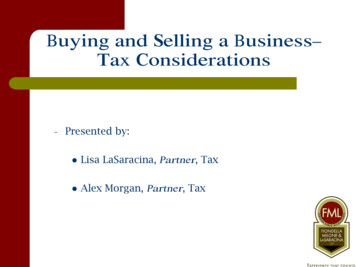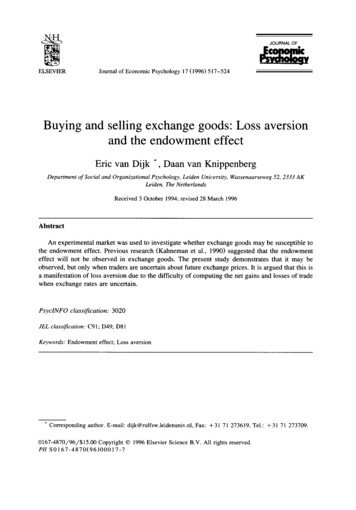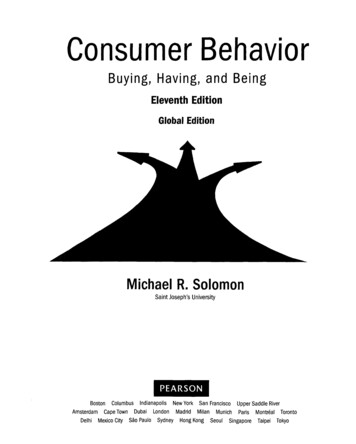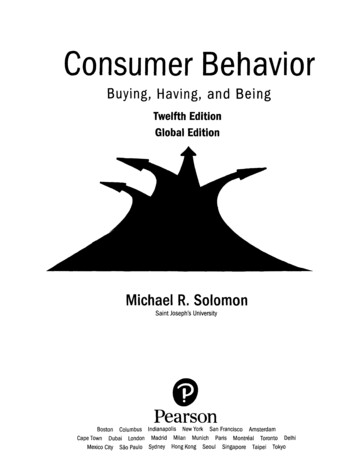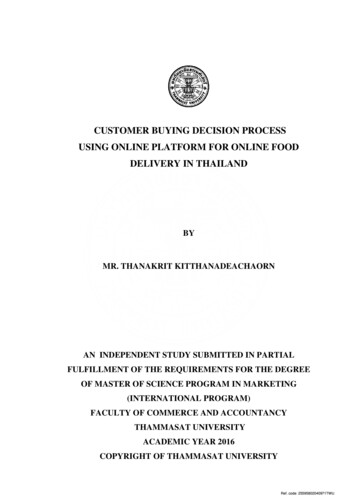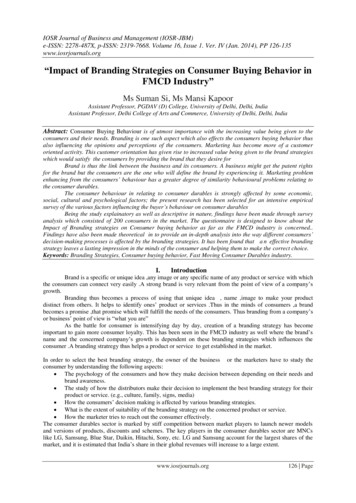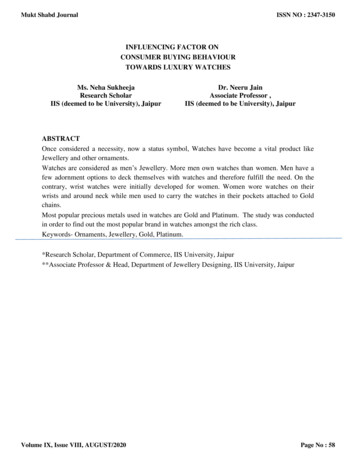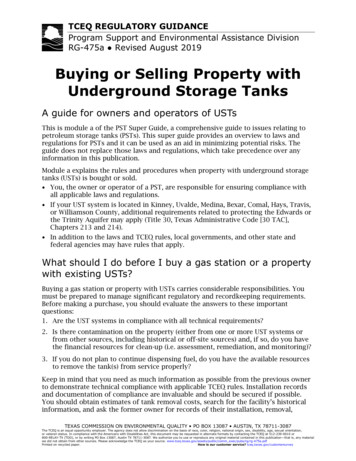
Transcription
TCEQ REGULATORY GUIDANCEProgram Support and Environmental Assistance DivisionRG-475a Revised August 2019Buying or Selling Property withUnderground Storage TanksA guide for owners and operators of USTsThis is module a of the PST Super Guide, a comprehensive guide to issues relating topetroleum storage tanks (PSTs). This super guide provides an overview to laws andregulations for PSTs and it can be used as an aid in minimizing potential risks. Theguide does not replace those laws and regulations, which take precedence over anyinformation in this publication.Module a explains the rules and procedures when property with underground storagetanks (USTs) is bought or sold. You, the owner or operator of a PST, are responsible for ensuring compliance withall applicable laws and regulations. If your UST system is located in Kinney, Uvalde, Medina, Bexar, Comal, Hays, Travis,or Williamson County, additional requirements related to protecting the Edwards orthe Trinity Aquifer may apply (Title 30, Texas Administrative Code [30 TAC],Chapters 213 and 214). In addition to the laws and TCEQ rules, local governments, and other state andfederal agencies may have rules that apply.What should I do before I buy a gas station or a propertywith existing USTs?Buying a gas station or property with USTs carries considerable responsibilities. Youmust be prepared to manage significant regulatory and recordkeeping requirements.Before making a purchase, you should evaluate the answers to these importantquestions:1. Are the UST systems in compliance with all technical requirements?2. Is there contamination on the property (either from one or more UST systems orfrom other sources, including historical or off-site sources) and, if so, do you havethe financial resources for clean-up (i.e. assessment, remediation, and monitoring)?3. If you do not plan to continue dispensing fuel, do you have the available resourcesto remove the tank(s) from service properly?Keep in mind that you need as much information as possible from the previous ownerto demonstrate technical compliance with applicable TCEQ rules. Installation recordsand documentation of compliance are invaluable and should be secured if possible.You should obtain estimates of tank removal costs, search for the facility’s historicalinformation, and ask the former owner for records of their installation, removal,TEXAS COMMISSION ON ENVIRONMENTAL QUALITY PO BOX 13087 AUSTIN, TX 78711-3087The TCEQ is an equal opportunity employer. The agency does not allow discrimination on the basis of race, color, religion, national origin, sex, disability, age, sexual orientation,or veteran status. In compliance with the Americans with Disabilities Act, this document may be requested in alternate formats by contacting the TCEQ at 512-239-0010 or800-RELAY-TX (TDD), or by writing PO Box 13087, Austin TX 78711-3087. We authorize you to use or reproduce any original material contained in this publication—that is, any materialwe did not obtain from other sources. Please acknowledge the TCEQ as your source. www.tceq.texas.gov/assets/public/comm exec/pubs/rg/rg-475a.pdfPrinted on recycled paper.How is our customer service? tceq.texas.gov/customersurvey
Buying or Selling Property with Underground Storage TanksTCEQ publication RG-475aupgrades, releases and corrosion protection, and other important documents relatedto the USTs performance and maintenance.You should document that any claims made by the seller can be verified withinstallation, removal, and compliance records. If those records are not available fromthe seller, you will need to obtain documentation through other sources, such as USTcontractors who performed the installation or repair work. This information must beadequate to satisfy the requirements of a TCEQ investigation.An environmental study called a Phase I assessment is commonly conducted prior tothe transfer of ownership of commercial property to identify potential environmentalcontamination from on-site and adjacent properties. Additionally, a Phase IIassessment is conducted to determine if there is contamination at the site. A Phase IIassessment includes soil and groundwater samples. Although the Phase I and II studiesare valuable tools to document existing contamination at the site, they usually do notaddress historical design, installation, upgrade, and day-to-day operational records.USTs may have been installed and registered at the property, but have beenpermanently removed from service after installation. If the tanks have beenpermanently removed from service, you should request a copy of the ReleaseDetermination Report (form TCEQ-00621) or other report documenting the removal ofthe tank system and any confirmation sampling that may have been conducted.It is essential for you, as a prospective property owner, to determine whether the TCEQhas issued a “no further action” letter to a previous owner indicating that the siteneeds no further study. If the previous owner does not have the letter, you can contactthe TCEQ Remediation Division to ask for a copy for your records at 512-239-2200.How can I obtain information about the USTs from theTCEQ?Use the resources in this list to research and find information about properties withUSTs. The TCEQ Central Registry Database can tell you whether a facility is registeredwith the TCEQ and provides information submitted by the owner, or arepresentative of the owner, about the PST system. However, records from thedatabase do not replace information from historical documents, such as originalinstallation records. The database may also indicate whether the facility is, or everwas, registered as a leaking petroleum storage tank (LPST) site. The Central RegistryDatabase is located at www.tceq.texas.gov/permitting/central registry . The Petroleum Storage Tank (PST) Records and Datasets webpage providesdownloadable files, including a statewide listing of LPST sites and PST facility data(including USTs). You can search raw data located at asets-records.html . The Compliance History Database is another source of information. State rulesrequire the TCEQ to maintain and publish compliance histories for many of thecompanies, individuals, agencies, and other entities that it regulates. Historiesbecome a rating of a customer’s “distance from compliance.” Poor ratings can causedenial of permits, stricter regulation, and higher penalties. It is important toremember that a buyer inherits the compliance history rating of the facility. You2August 2019
TCEQ publication RG-475aBuying or Selling Property with Underground Storage Tankscan search the compliance history database at www.tceq.texas.gov/enforcement/history/search.html . Check to see if there is a pending enforcement action against the current owner ofthe UST system on the property. To search the status of enforcement actions thatare currently open, go to our enforcement actions webpage at www.tceq.texas.gov/enforcement/penenfac/index.html . You may also perform an open records request online, or via email, fax, or mail toobtain documents, pending applications, ongoing compliance or enforcementactions, or other records. Go to our open records webpage at qinfo.html for moreinformation. For additional current and historical registration information, you may contactthe PST Registration Team at 512-239-2160. For additional information on cleanup requirements or USTtechnical requirements, you may contact the Remediation Division at 512-2392200.What should I consider if there is contamination?The TCEQ does not prevent the sale of LPST sites. All parties involved in the sale ofproperty with an LPST should be aware of the cleanup requirements and potentialcosts.Parties may choose to negotiate the terms regarding any required cleanup byestablishing a letter of credit or negotiating the price. However, the TCEQ will not bebound by any agreement between the parties, and a buyer of an LPST site is not eligiblefor the Innocent Owner/Operator Program.All interested parties may consider hiring a qualified environmental consultant andpossibly an attorney to evaluate existing information.What are my options regarding existing UST systems?If USTs remain in the ground at the time of the sale of real property, they are generallyconsidered part of the property and are transferred with it, unless the sellerspecifically maintains ownership of them. The buyer is responsible for keeping (ormaking) the tanks compliant with applicable rules.All UST systems must be maintained in compliance with applicable TCEQ rules,whether or not they are in use. If you are going to use a UST system, it must complywith all technical and administrative requirements, including: release detection, corrosion protection, spill and overfill, prevention equipment financial assurance, registration and self-certification, operator training,August 20193
Buying or Selling Property with Underground Storage TanksTCEQ publication RG-475a recordkeeping, and any other requirements that apply (such as Stage I Vapor Recovery).Request, from the seller, all existing records associated with the UST system, including: installation documentation, owner’s manuals, and compliance documentation.If the seller cannot provide these records, you may be required to re-create them orperform additional tests and actions to keep the UST system in compliance.If you are not going to use a UST system, an option for temporarily removing the USTsystem from service is described in 30 TAC 334.54 and outlined in TemporarilyRemoving PSTs from Service (TCEQ publication RG-475l). Three options forpermanently removing the UST system from service (along with additionalinformation) are described in 30 TAC 334.55. Those three options are:1. removal from the ground,2. abandonment in place (proper emptying by a licensed UST contractor andfilling with sand, cement, etc.), or3. permanent change in service (storage of non-regulated substances).Regardless of the option you choose, the work will need to be performed by a TCEQlicensed UST contractor, and a comprehensive site assessment must be performed todetermine whether a release has occurred from any part of the UST systems. For moreinformation on permanent removal from service, see Permanently Removing PetroleumStorage Tanks from Service (TCEQ publication RG-475m).It is a good business practice to secure bids on possible actions that may be necessaryto ensure the tank(s)’ compliance (removal, upgrades, and/or samples to determine ifcontamination is present) before taking ownership of the property. There is nosubstitute for soil and groundwater sampling to determine if there is subsurfacecontamination.4August 2019
TCEQ publication RG-475aBuying or Selling Property with Underground Storage TanksWhat Do I Need to Report?Table 1 summarizes notification and recordkeeping requirements when property withUSTs are sold or purchased.Table 1: Responsibilities of sellers and purchasers of USTsResponsiblePartyActionSellerWritten disclosure that the tank is regulated by the TCEQ beforethe property is transferred to the purchaser (30 TAC 334.9)PurchaserUpdate and submit form with tank status and ownershipregistration within 30 days of sale (Form TCEQ-00724)PurchaserConstruction notification to TCEQ 30 days prior to majorconstruction activities (Form TCEQ-00495)PurchaserRecord keeping in accordance with 30 TAC 334.10Under 30 TAC 334.9, written notification from the seller to the buyer must include thenames and addresses of the seller (or grantor) and the purchaser (or grantee), thenumber of tanks involved, a description of each tank (capacity, tank material, andproduct stored, if applicable), and the agency's designated facility identificationnumber (if the entire facility is being conveyed). The following certification statementis sufficient:The underground storage tank (or tanks) included in thisconveyance is (are) presumed to be regulated by the TexasCommission on Environmental Quality and may be subjectto certain requirements for registration, compliance selfcertification, construction notification, and otherrequirements found in Title 30, Texas Administrative Code,Chapter 334.For further information regarding tank registration, refer to Petroleum Storage TankRegistration and Self Certification (TCEQ publication RG-475d).Where do I find more information?Laws and regulations pertaining to the PST program are found in the Texas WaterCode, Chapter 26, Subchapter I, available at tm and in 30 TAC 334available at texreg.sos.state.tx.us/public/readtac ext.ViewTAC?tac view 4&ti 30&pt 1&ch 334 .Links to additional webpages about registering PSTs, technical requirements forregulated PSTs, and LPST cleanup are available at www.tceq.texas.gov/agency/pst cert.html .August 20195
Buying or Selling Property with Underground Storage TanksTCEQ publication RG-475aComplete technical standards for USTs are located in 30 TAC 334, Subchapter Cavailable at texreg.sos.state.tx.us/public/readtac ext.ViewTAC?tac view 5&ti 30&pt 1&ch 334&sch C&rl Y .Requirements for tanks in the Edwards Aquifer are in 30 TAC 213 available at texreg.sos.state.tx.us/public/readtac ext.ViewTAC?tac view 4&ti 30&pt 1&ch 213 .Requirements for tanks over other aquifers are in 30 TAC 214 available at texreg.sos.state.tx.us/public/readtac ext.ViewTAC?tac view 4&ti 30&pt 1&ch 214&rl Y .Guidance for conducting assessment and corrective action at leaking UST sites isavailable in the Remediation Division’s guidance Investigating and ReportingReleases from Petroleum Storage Tanks (TCEQ publication RG-411) available at www.tceq.texas.gov/publications/rg/rg-411.html .Search for TCEQ publications online at www.tceq.texas.gov/publications .For confidential environmental compliance assistance for small businesses and localgovernments, contact Small Business and Local Government Assistance via thehotline at 800-447-2827 or online at www.TexasEnviroHelp.org .6August 2019
Buying or Selling Property with Underground Storage Tanks A guide for owners and operators of USTs This is module a of the PST Super Guide, a comprehensive guide to issues relating to petroleum storage tanks (PSTs). This super guide provides an overview to laws and regulations for PSTs and it
